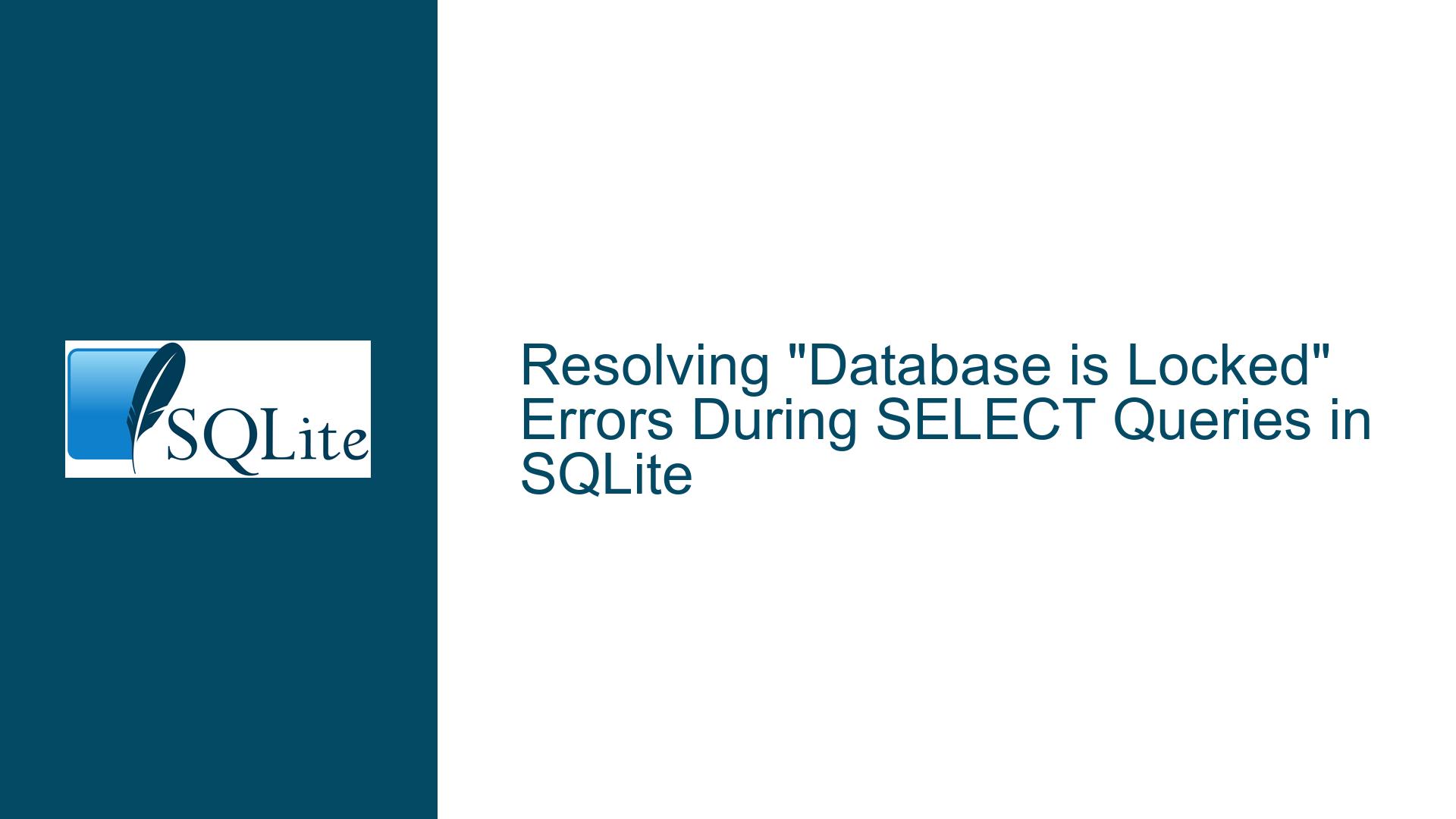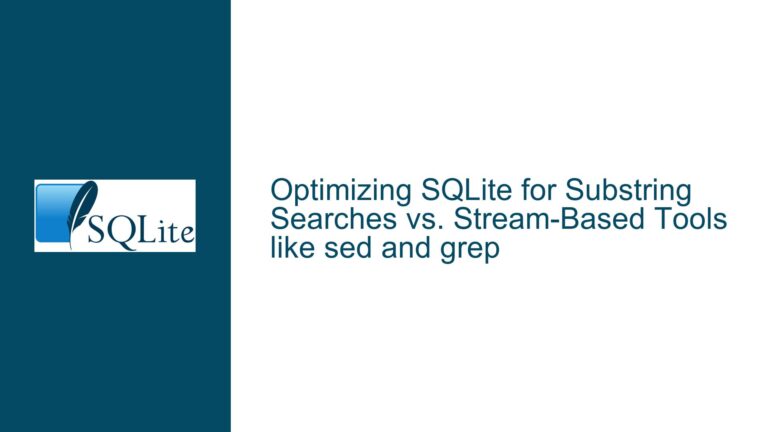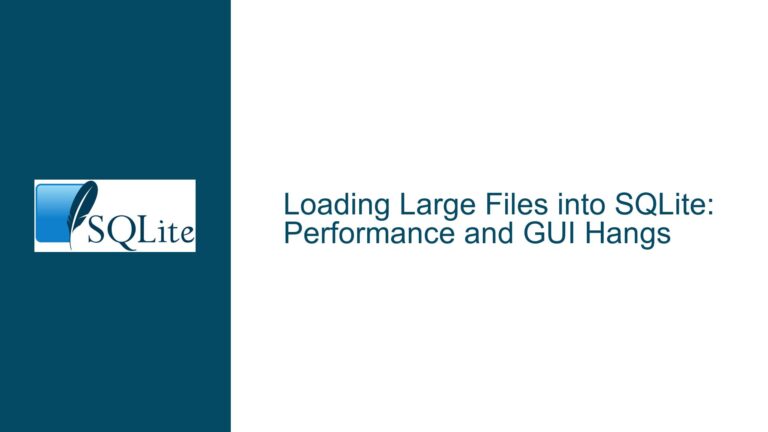Resolving “Database is Locked” Errors During SELECT Queries in SQLite
Issue Overview: SELECT Queries Blocked by Write Transaction Locks
The "database is locked" error during SELECT operations in SQLite occurs when a read operation attempts to access a database file while another process or thread holds an exclusive lock. SQLite uses a file-based locking mechanism to enforce transaction isolation, where write operations (INSERT/UPDATE/DELETE) require exclusive locks during COMMIT phases. While SELECT statements typically use shared locks, they can still be blocked if the database is in a transitional state between locks. This behavior is especially pronounced in environments with concurrent access, such as multi-threaded applications or network-shared databases.
In the scenario described, the SELECT query fails intermittently despite the database being rarely modified. The root cause lies in SQLite’s locking hierarchy: when a write transaction commits, it briefly holds an exclusive lock to finalize changes. If a SELECT query attempts to acquire a shared lock during this window, it will fail with "database is locked." This is exacerbated when the database resides on a Windows network share, where file locking semantics are less reliable compared to local storage. The absence of Write-Ahead Logging (WAL) mode (which is incompatible with network shares) further compounds the issue, as WAL allows concurrent reads and writes by default.
Key factors contributing to this problem include:
- Exclusive Lock Contention: The COMMIT phase of a write transaction temporarily blocks all other operations.
- Network File System Limitations: Windows network shares introduce latency and inconsistencies in file locking.
- Insufficient Busy Timeout Configuration: Default timeout settings may not allow sufficient retry attempts for locks to resolve.
Possible Causes: Concurrency, Locking Hierarchy, and Environmental Constraints
1. Write Transaction Interference During COMMIT
SQLite employs a five-state locking model: UNLOCKED, SHARED, RESERVED, PENDING, and EXCLUSIVE. A SELECT query acquires a SHARED lock, while a write transaction escalates through RESERVED, PENDING, and EXCLUSIVE locks. The critical moment occurs during COMMIT, where the writer holds an EXCLUSIVE lock to update the database file. If a reader attempts to acquire a SHARED lock during this period, it will fail immediately unless a busy timeout is configured. This is more likely in high-concurrency environments or when write transactions are long-running.
2. Network Share File Locking Limitations
Storing SQLite databases on Windows network shares introduces two risks:
- Locking Latency: Network delays can cause locks to be held longer than expected, increasing the probability of contention.
- Incomplete Lock Propagation: Some network file systems (e.g., SMB/CIFS) do not reliably propagate lock states across clients, leading to false "database is locked" errors.
3. Suboptimal Transaction and Timeout Settings
- Default Busy Timeout: SQLite’s default busy timeout is 0 milliseconds, meaning it does not retry locked operations. Even if a timeout is set (e.g., via
sqlite3_busy_timeout), insufficient duration or misconfiguration in the driver layer (e.g., System.Data.SQLite) can lead to premature failures. - Transaction Scope Mismatch: Using
BEGIN DEFERRED(the default) for write transactions may delay lock acquisition until the first write operation, increasing the window for contention. Conversely,BEGIN IMMEDIATEorBEGIN EXCLUSIVEpreemptively escalates locks but requires careful coordination.
Troubleshooting Steps, Solutions & Fixes
1. Diagnosing Lock Contention and Environmental Factors
Step 1: Identify Concurrent Writers
Use tools like sqlite3_db_status (C API) or diagnostic queries to monitor active transactions:
SELECT * FROM sqlite_master WHERE type='table' AND name='sqlite_stat1';
If this query blocks, it indicates an active write transaction holding a RESERVED or EXCLUSIVE lock.
Step 2: Analyze Network Share Behavior
Test the database on a local drive. If the "database is locked" error disappears, the network file system is likely contributing to lock contention. For Windows shares, ensure:
- The share uses SMB 3.0 or later with continuous availability enabled.
- Antivirus/backup software is not scanning the database file, which can interfere with locks.
Step 3: Audit Transaction Boundaries
Review application code to ensure write transactions are as short as possible. Long-running transactions increase the likelihood of lock conflicts. For example:
using (SQLiteTransaction transaction = connection.BeginTransaction())
{
// Execute multiple writes here
transaction.Commit(); // EXCLUSIVE lock held briefly
}
2. Configuring Busy Timeouts and Retry Logic
Step 1: Set an Appropriate Busy Timeout
In System.Data.SQLite, configure the BusyTimeout property to enable automatic retries:
SQLiteConnectionStringBuilder builder = new SQLiteConnectionStringBuilder
{
DataSource = "mydb.db",
DefaultTimeout = 30, // Connection timeout
BusyTimeout = 5000 // 5-second busy timeout
};
using (SQLiteConnection conn = new SQLiteConnection(builder.ConnectionString))
{
conn.Open();
}
This translates to sqlite3_busy_timeout(5000) in the native API.
Step 2: Implement Application-Level Retries
For transient errors, wrap database operations in a retry loop:
int retries = 3;
int delayMs = 100;
for (int i = 0; i < retries; i++)
{
try
{
ExecuteSelectQuery();
break;
}
catch (SQLiteException ex) when (ex.ResultCode == SQLiteErrorCode.Busy)
{
if (i == retries - 1) throw;
Thread.Sleep(delayMs);
delayMs *= 2; // Exponential backoff
}
}
3. Mitigating Network Share Limitations
Step 1: Use Read-Only Attachments for Secondary Databases
When querying auxiliary databases (e.g., via ATTACH), open them in read-only mode to avoid unnecessary locks:
ATTACH 'file:///mnt/shared/aux.db?mode=ro' AS aux;
Step 2: Centralize Write Operations
Designate a single application instance or service as the sole writer to the database. Route all write requests through this instance using a queueing mechanism (e.g., RabbitMQ or in-memory channels).
Step 3: Optimize File System Coordination
- Disable opportunistic locking (OpLock) on the network share to prevent clients from caching file states:
Set-SmbClientConfiguration -EnableOplocks $false - Mount the share with the
nolockoption on Linux clients accessing the database.
4. Advanced Transaction Management
Step 1: Use IMMEDIATE Transactions for Writers
Instruct write operations to begin with BEGIN IMMEDIATE to acquire a RESERVED lock early, reducing contention windows:
using (SQLiteCommand cmd = new SQLiteCommand("BEGIN IMMEDIATE", connection))
{
cmd.ExecuteNonQuery();
}
// Perform writes
Step 2: Leverage Connection Pooling
Configure connection pooling to reuse connections with established locks, minimizing setup/teardown overhead:
SQLiteConnectionStringBuilder builder = new SQLiteConnectionStringBuilder
{
Pooling = true,
MaxPoolSize = 10
};
Step 3: Monitor Lock States Programmatically
Use the sqlite3_snapshot API (SQLite 3.28.0+) to capture database states for consistent reads without blocking:
// Requires native interop
sqlite3_snapshot* snapshot;
sqlite3_snapshot_get(db, "main", &snapshot);
// Perform read operations against the snapshot
sqlite3_snapshot_free(snapshot);
5. Architectural Adjustments for High Concurrency
Step 1: Migrate to Client-Server Database Systems
If network-shared SQLite proves untenable, transition to a client-server database like PostgreSQL or MySQL, which handle concurrent access more gracefully.
Step 2: Implement Caching Layers
Use an in-memory cache (e.g., Redis, Memcached) to serve frequent read requests, reducing direct database load.
Step 3: Database Sharding
Partition the database into smaller, less contentious shards based on application logic (e.g., by user ID or region).
By systematically addressing transaction boundaries, timeout configurations, and environmental constraints, developers can mitigate "database is locked" errors during SELECT operations. While SQLite’s simplicity makes it vulnerable to concurrency issues on network shares, strategic use of retries, read-only attachments, and architectural adjustments can restore reliability in most scenarios.






